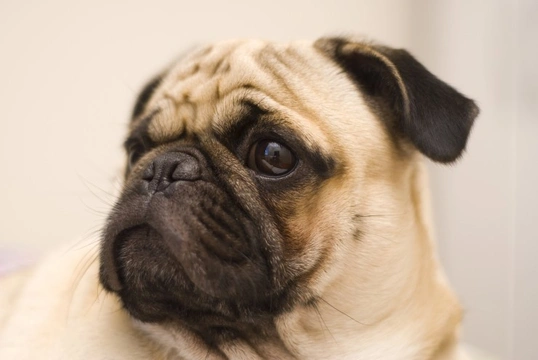
All about brachycephalic syndrome in dogs
Brachycephalic syndrome is a condition that can affect dogs (and cats) with an exaggeratedly shortened muzzle, such as the Pug, Cavalier King Charles spaniel, and many dogs of different bulldog breeds. Dogs that have a muzzle of this type are said to be brachycephalic.
The syndrome itself is caused by a combination of four different anomalies of the anatomy of the dog, which are stenotic nares, an elongated soft palate, everted laryngeal saccules, and a hypoplastic trachea. The combination of all four of these factors can lead to difficulties in breathing normally and being able to inhale enough air, particularly when the dog is working and breathing hard, is suffering from stress, is hot, or in any other situation that naturally leads to panting.
Not being able to get enough air in this way leads to a build-up of carbon dioxide within the body, which increases the heart rate and attempted rate of respiration, leading to a catch 22 situation that can actually prove life-threatening.
In this article, we will look at brachycephalic syndrome in more detail, and examine the risk factors for the condition and what it involves. Read on to learn more about brachycephalic syndrome in dogs.
What type of dogs are at risk of brachycephalic syndrome?
Any dog breed or type with a short, squat muzzle is at risk of brachycephalic syndrome, and certain breeds are widely renowned for suffering from the condition. These breeds include:
- Affenpinscher
- American Cocker Spaniel
- Boston terrier
- Boxer
- Brussels griffon
- Bulldogs of all types
- Bullmastiff
- Cane Corso
- Cavalier King Charles Spaniel
- Chow Chow
- Dogue de Bordeaux
- English Mastiff
- English bulldog
- French bulldog
- Japanese Chin
- King Charles spaniel
- Neapolitan mastiff
- Newfoundland
- Pekingese
- Presa Canario
- Pug
- Shar-Pei
- Shih Tzu
- Silky terrier
- Tibetan spaniel
What are the symptoms of brachycephalic syndrome in dogs?
The core symptom of brachycephalic syndrome is breathing difficulties, which can manifest in a variety of different ways. Important signs to be on the lookout for in brachycephalic dogs include:
- Loud or laboured breathing
- Making a wheezing noise through the nostrils
- Open-mouthed breathing when at rest
- Hyperextension of the head and neck in order to open the airways
- Sleeping with the chin elevated
- Sleeping with a toy or other item within the mouth to keep the mouth open to breathe
- Blue colouration of the skin and lips in extreme attacks
- Sleep apnoea
- A poor tolerance for heat and strenuous exercise
- Gagging or regurgitating food frequently
Within brachycephalic dogs, the condition usually progressively worsens throughout the first year of life, and by one year old, will generally be well established.
Can brachycephalic syndrome be prevented?
In dogs that are prone to the condition, several steps can be taken to avoid situations that can lead to attacks of brachycephalic syndrome and to keep affected dogs safe.
Carrying around too much extra weight can greatly exacerbate the condition, so keeping the dog at a healthy weight is vital. Special care should be taken during hot weather to ensure that the dog can keep cool without having to pant excessively, and shade, water and cooler areas should be provided.
Strenuous exercise can exacerbate the condition, so try to keep exercise light and frequent rather than high-energy.
Using a harness that fits around the chest is also a better choice for brachycephalic dogs than a collar and lead, as the pressure of the collar can narrow the trachea, adding to further difficulties getting enough air.
Is there any treatment for severe cases?
The shorter and more flattened the muzzle of the dog, the more prone they are likely to be to problems with their breathing, and dogs with exaggeratedly flattened faces should not be bred from.
In dogs that suffer from frequent or severe problems with breathing due to brachycephalic syndrome, various surgical options may be considered in order to correct the greatest risk factors and enable a more normal life for the dog in question.
Some surgical procedures that may help include widening the nostrils to enable more airflow to enter the lungs, removing any excess soft tissue from the soft palate in order to elongate it, and removing everted laryngeal saccules.
Most dogs with overly shortened muzzles that are likely to be afflicted with brachycephalic syndrome throughout their lives will show clear signs of the condition and associated discomfort by the time they are a year old, and without intervention, the condition will not improve over time and may progressively worsen. In order to give the dog the best chance of a normal life and not cause them to suffer unduly prior to treatment, if surgery is considered to be a viable option for affected dogs, it is best performed when the dog is as young as possible.
Many owners of brachycephalic dog breeds do not realise that the dog has a problem, and there is a widely held perception that some of the issues that arise are simply a breed trait of the dog. However, treatment and surgical correction can be performed to improve the dog’s quality of life, and regular check-ups with the vet will help to ensure that any problems can be diagnosed and dealt with promptly.



